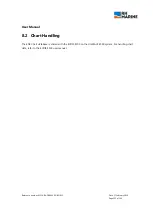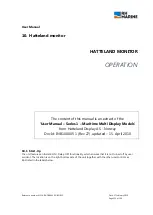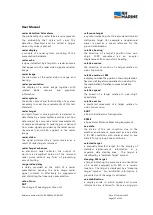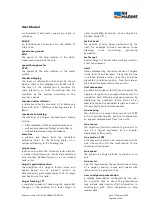
User Manual
Reference number: 4111A-RADAR4600-GBD-R1.1
Date: 27 February 2018
Page 145 of 149
of the ship's movement through the water,
expressed in angular units from true north.
course up - C up
an azimuth stabilised display in which the
bearing scale can be orientated so that own
ship’s course on the bearing scale is vertically
above the CCRP. The heading line will continue
to point from the CCRP to own ship’s
referenced heading on the bearing scale. If own
ship’s heading differs from the course, then the
heading line will not point vertically upwards
from the CCRP until the bearing scale is reset
(manually or automatically) to reflect the
course alteration.
dangerous target
a target whose predicted CPA and TCPA are
violating the values as preset by the operator.
The respective target is marked by a
“dangerous target” symbol.
default
a predefined condition set either by the user or
the equipment manufacturer.
ECDIS
an Electronic Chart Display and Information
System, which complies with IMO resolution
A.817(19) amended by MSC.64(67) Annex 5 and
MSC.86(70) Annex 4, and IEC 61174.
ECDIS display base
the level of information which cannot be
removed from the ECDIS display, consisting of
information which is required at all times in all
geographic areas and all circumstances. It is
not intended to be sufficient for safe
navigation.
ECDIS standard display
the level of information that should be shown
when a chart is first displayed on ECDIS. The
level of the information it provides for route
planning or route monitoring may be modified
by the mariner according to the mariner's
needs.
ENC
an Electronic Navigational Chart. The database
standardised as to content, structure and
format according to relevant IHO standards and
issued by, or on the authority of, a Government.
EPFS
an electronic position fixing system.
ERBL
an electronic bearing line carrying a marker,
which is combined with the variable range
marker, used to measure range and bearing
from own ship or between two objects.
evaporation duct
a low lying duct (a change in air density) that
traps the radar energy so that it propagates
close to the sea surface. Ducting may enhance
or reduce radar target detection ranges.
exclusion zone
an area which may exclude the automatic
acquisition for target tracking and/or may
suppress the automatic activation of sleeping
AIS targets.
ground stabilisation
a display mode in which speed and course
information are referred to the ground, using
ground track input data, or EPFS as reference.
heading
the horizontal direction that the bow of a ship
is pointing at any instant, expressed in angular
units from a reference direction.
heading line
a graphic line on a radar presentation drawn
from the consistent common reference point to
the bearing scale to indicate the heading of the
ship.
H up
a presentation mode which is orientated “up”
toward the top of the bearing scale. Radar
targets and tracked targets are shown at their
measured distances and moving in a direction
relative to own ship’s heading. In head up, the
top of the bearing scale shows 000 degrees.
Target trails are relative. It is possible to have
an azimuth stabilised head up mode where the
top of the bearing scale shows own ship’s
heading. In this case, target trails may be true
or relative.
HSC
a
High Speed Craft (HSC) and are vessels which
comply with the definition in SOLAS for high
speed craft.
symbol
a graphic that provides or signifies a control
function capability.



















